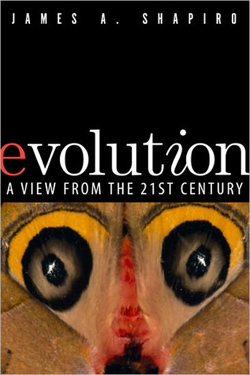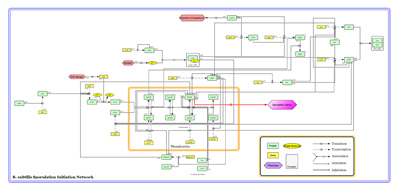Evolution - A view from the 21st century
This article is written by Kevin Moss, a former biology teacher who now works in the financial services regulation industry. Kevin is a regular blogger at www.theobloggie.wordpress.com and takes an interest in issues of science and faith. He graduated BSc in Environmental Sciences and has recently completed a Masters Degree in Christian Apologetics from Biola University, Los Angeles.
 This is the title of a ground-breaking volume written by Dr James A. Shapiro, Professor of Biochemistry and Molecular Biology at the University of Chicago. Published in June 2011 by FT Press Science, I obtained my copy within a month and read it avidly until I think I had managed at least to absorb the gist of what Shapiro has been arguing about the molecular basis for evolution. For this was one of the least accessible texts I had worked through in recent years, as it contains a substantial amount of technical content regarding molecular systems: it is no wonder that propagandists, intent on promoting atheist mantras, usually restrict their consideration to the Big Picture, and tend to ignore the inconvenient data unearthed by researchers such as Shapiro.
This is the title of a ground-breaking volume written by Dr James A. Shapiro, Professor of Biochemistry and Molecular Biology at the University of Chicago. Published in June 2011 by FT Press Science, I obtained my copy within a month and read it avidly until I think I had managed at least to absorb the gist of what Shapiro has been arguing about the molecular basis for evolution. For this was one of the least accessible texts I had worked through in recent years, as it contains a substantial amount of technical content regarding molecular systems: it is no wonder that propagandists, intent on promoting atheist mantras, usually restrict their consideration to the Big Picture, and tend to ignore the inconvenient data unearthed by researchers such as Shapiro.
What Shapiro and his team have discovered at the molecular level is utterly inimical to the traditional neo-Darwinian synthesis which has held sway for the better part of a century, and now forms an unquestionable blanket of dogma, used as a blunt tool to root out ‘heretics’ within academia. For that is precisely how the system now operates: those whose work produces results which are contrary to the accepted paradigm are warned off, so it is unsurprising to discover an atmosphere of compliance amongst those who have yet to earn tenure. A very recent example of this established pattern occurred in the publication of a paper entitled Biomechanical Characteristics of Hand Coordination in Grasping Activities of Daily Living published by Ming-Jin Liu, Cai-Hua Xiong , Le Xiong and Xiao-Lin Huang. The paper was published on the 5th January, and then almost immediately retracted (by PLOS ONE) following howls of protest over “inappropriate language”. Perhaps that “inappropriate language” included ad hominems, or homophobic expressions, or involved some other crime against political correctness?
Nope. The authors had drawn what most of us would consider to be completely appropriate conclusions about the relationship between evidence of design, and the role of a designer/creator in relation to the end product. This was sufficient to tip a relentlessly atheistic community over the edge. One is reminded of the baying mob around Madame Guillotine in the late 1700s, also a by-product of Enlightenment thinking.
Shapiro is a brave man to swim against the tide, but then his scientific work at a molecular level shows that Darwinian Orthodoxy cannot be correct: if there is such a thing as evolution, it is not primarily dependent upon undirected, or random genetic variation (such as mutations, which are almost invariably deleterious in their effect). No, in practice, living systems show telos, or purpose. Molecular systems are (a) far more complex than we had understood them to be, and (b) they are directed, purposeful. Indeed, molecular change often occurs in anticipation of external environmental influences.
 I am reminded of an incident that Dr Steve Meyer relates. The Discovery Institute draws on the services of leading Microsoft programmers, in their spare time, to develop computer simulations of genetic models. These experts have no religious axes to grind, indeed they usually come from a uniformly secular background. On more than one occasion, Meyer observes that these experts appear, ashen-faced, at his office door once they have completed their research into molecular programming. The response is almost invariably the same: decades of training and experience in the field has not prepared them for the sheer sophistication and complexity of what actually goes on at a molecular level. By comparison, what they’ve been doing at Microsoft is like a child pressing the buttons on a simple pocket-calculator.
I am reminded of an incident that Dr Steve Meyer relates. The Discovery Institute draws on the services of leading Microsoft programmers, in their spare time, to develop computer simulations of genetic models. These experts have no religious axes to grind, indeed they usually come from a uniformly secular background. On more than one occasion, Meyer observes that these experts appear, ashen-faced, at his office door once they have completed their research into molecular programming. The response is almost invariably the same: decades of training and experience in the field has not prepared them for the sheer sophistication and complexity of what actually goes on at a molecular level. By comparison, what they’ve been doing at Microsoft is like a child pressing the buttons on a simple pocket-calculator.
Atheist polemicists love to use the example of Galileo to propose some kind of artificial conflict between religion and science. Usually, they are reinventing history to do so. What is true about that period was that the Aristotelian consensus was suppressing genuine scientific progress. In a modern context, that’s exactly where we now are with Darwinian dogma, and the discoveries being uncovered at a genetic level.
Image credits:
Thumbnail - M. Sri Teja and Maneka; this file is licensed under the Creative Commons Attribution-Share Alike 3.0 Unported licence.
Book cover - © Financial Times/ Prentice Hall
Gene regualtory netowrk schematic - as thumbnail above.